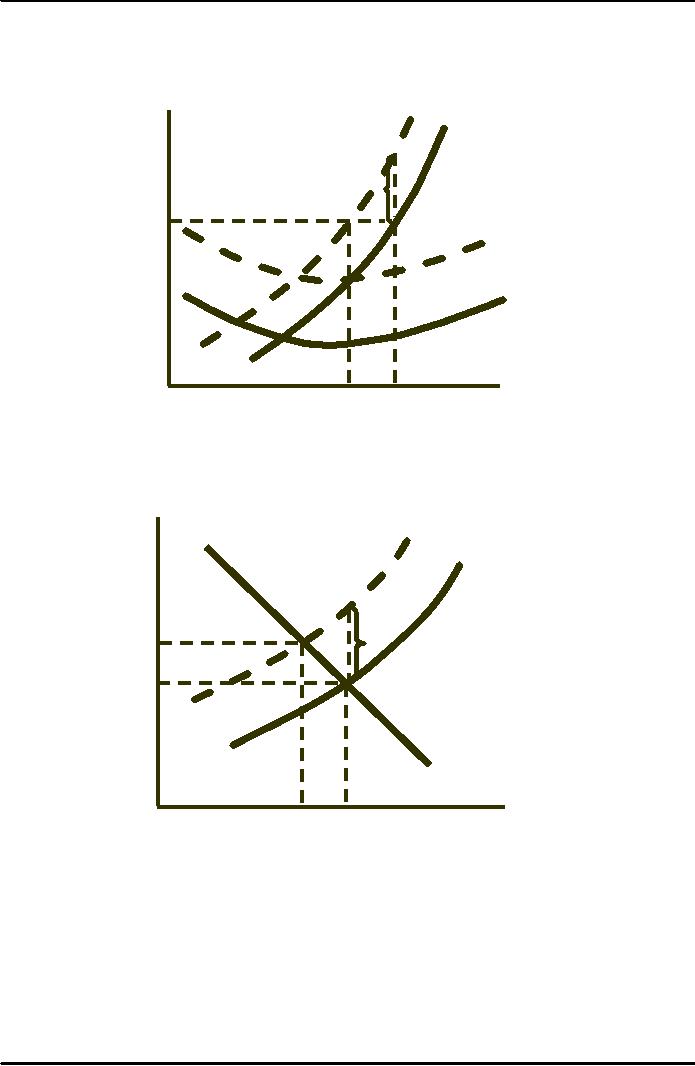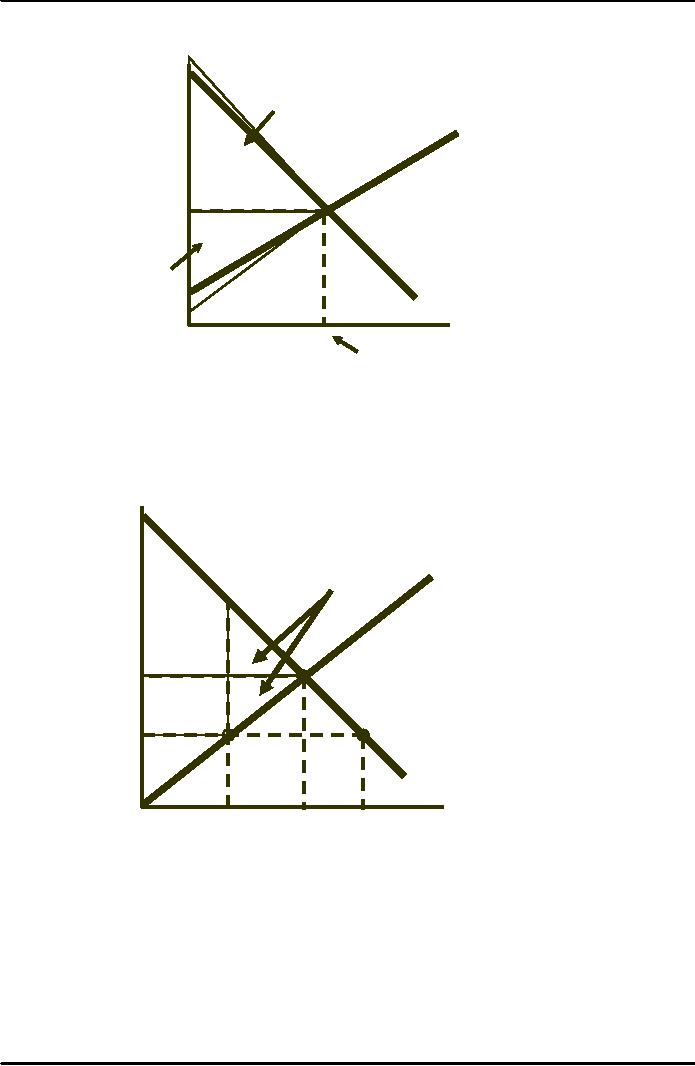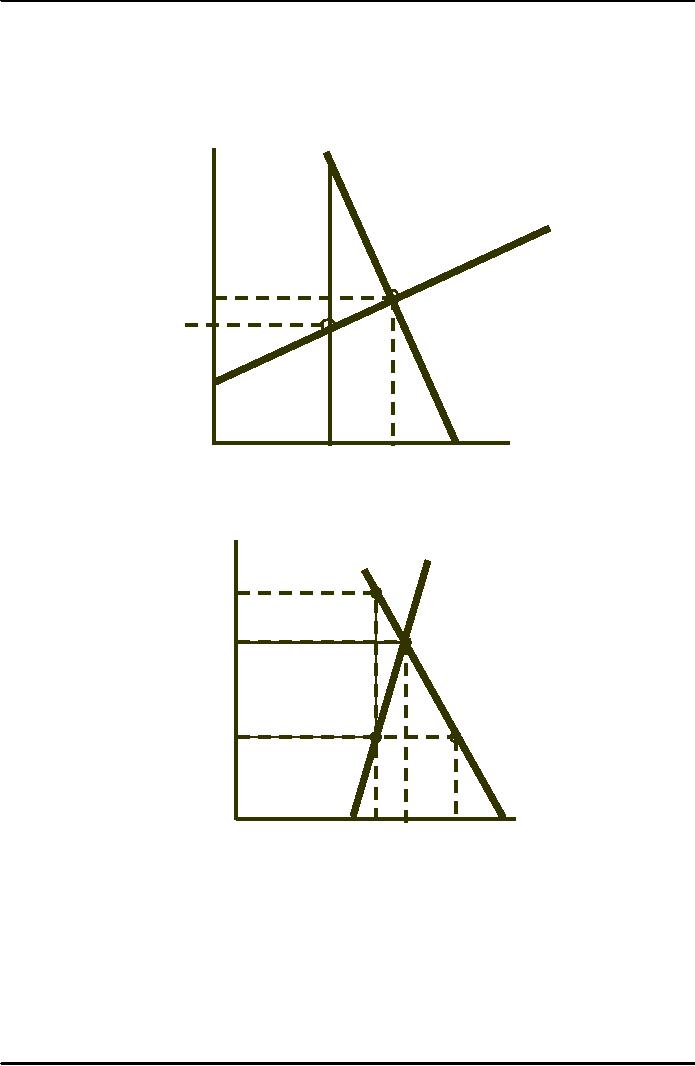 |

Microeconomics
ECO402
VU
Lesson
26
The
Industry's Long-Run Supply
Curve
Long-Run
Elasticity of Supply
1)
Constant-cost industry
·
Long-run
supply is horizontal
·
Small
increase in price will
induce an extremely large
output increase
·
Long-run
supply elasticity is infinitely
large
·
Inputs
would be readily
available
2)
Increasing-cost industry
·
Long-run
supply is upward-sloping and
elasticity is positive
·
The slope
(elasticity) will depend on
the rate of increase in
input cost
·
Long-run
elasticity will generally be
greater than short-run
elasticity of supply
The
Industry's Long-Run Supply
Curve
Question:
Describe the
long-run elasticity of supply in a
decreasing -cost
industry.
The
Long-Run Supply of
Housing
Scenario
1: Owner-occupied housing
Suburban or
rural areas
National market
for inputs
Questions
Is this an
increasing or a constant-cost
industry?
What would
you predict about the
elasticity of supply?
Scenario
2: Rental property
Urban
location
High-rise
construction cost
Questions
Is this an
increasing or a constant-cost
industry?
What would
you predict about the
elasticity of supply?
The
Industry's Long-Run Supply
Curve
The
Effects of a Tax
In an earlier
chapter we studied how firms
respond to taxes on an
input.
Now, we will
consider how a firm responds
to a tax on its
output.
126

Microeconomics
ECO402
VU
Effect
of an Output Tax on a Competitive
Firm's Output
Price
MC2 =
MC1 + tax
The
firm will
MC
reduce
output to
($
per
An
output tax
the
point at which
unit
of
raises
the firm's
the
marginal cost
output)
marginal
cost by the
plus
the tax equals
amount
of the tax.
the
price.
t
P
AVC
AVC
q
q
Output
Effect
of
an
Output
Tax on Industry
Output
Price
S2 =
S1 + t
($
per
unit
of
S
output)
t
P
Tax
shifts S1 to S2 and
P
output
falls to Q2.
Price
increases
to P2.
D
Q
Q
Output
Evaluating
the
Gains & Losses from
Government Policies:
Consumer
& Producer Surplus
Review
Consumer
surplus is the
total benefit or value that
consumers receive beyond
what
they
pay for the
good.
Producer
surplus is the
total benefit or revenue
that producers receive
beyond what it
cost
to produce a good.
127

Microeconomics
ECO402
VU
Price
Consumer
Surplus
S
5
Between
0 and Q0
producers
receive
Producer
a
net gain from
Surplus
selling
each product--
producer
surplus.
D
0
Q
Quantity
Consumer
To
determine the welfare effect
of a governmental policy we can
measure the gain or loss
in
consumer
and producer surplus.
Welfare
Effects
Gains and
losses caused by government
intervention in the
market.
Suppose
the government
imposes
a price ceiling Pmax
Price
which
is below the
Market-clearing
price P0.
S
Deadweight
The
gain to consumers is
the
difference between
the
rectangle A
and
the
triangle
B.
B
P0
C
A
The
loss to producers is
the
sum of rectangle A
and
Pmax
triangle
C. Triangle
B
and
C togethermeasure
the
deadweight loss.
D
Q1
Q0
Q2
Quantity
Change
in
consumer
& producer surplus from
price controls
Observations:
The total
loss is equal to area B +
C.
The total
change in surplus = (A - B) + (-A - C) =
-B - C
The
deadweight
loss is the
inefficiency of the price
controls or the loss of the
producer
surplus
exceeds the gain from
consumer surplus.
128

Microeconomics
ECO402
VU
Observation
Consumers can
experience a net loss in
consumer surplus when the
demand is
sufficiently
inelastic
Effect
of Price Controls When
Demand Is Inelastic
If
demand is sufficiently
inelastic,
triangle B
can
D
Price
be
larger than rectangle
A
and
the consumer
suffers
a net loss from
S
price
controls.
P0
C
Example
A
Pmax
Oil
price controls
and
gasoline shortages
Quantity
Q2
Q1
Price
($/mcf)
D
S
The
gain to consumers
is
2.4
rectangle
A minus
triangle
B,
and the loss
B
to
2.0
producers
is rectangle
A
A
plus
triangle C.
C
(Pmax)1.0
30
Quantity
(Tcf)
0
5
15
1
10
20
25
Price
Controls and Natural Gas
Shortages
129

Microeconomics
ECO402
VU
The
Efficiency of a Competitive
Market
When
do competitive markets generate an
inefficient allocation of resources or
market
failure?
1)
Externalities
·
Costs or
benefits that do not show up
as part of the market price
(e.g. pollution)
2)
Lack of Information
·
Imperfect
information prevents consumers
from making utility-maximizing
decisions.
Government
intervention in these markets
can increase
efficiency.
Government
intervention without a market
failure creates inefficiency or
deadweight loss.
130
Table of Contents:
- ECONOMICS:Themes of Microeconomics, Theories and Models
- Economics: Another Perspective, Factors of Production
- REAL VERSUS NOMINAL PRICES:SUPPLY AND DEMAND, The Demand Curve
- Changes in Market Equilibrium:Market for College Education
- Elasticities of supply and demand:The Demand for Gasoline
- Consumer Behavior:Consumer Preferences, Indifference curves
- CONSUMER PREFERENCES:Budget Constraints, Consumer Choice
- Note it is repeated:Consumer Preferences, Revealed Preferences
- MARGINAL UTILITY AND CONSUMER CHOICE:COST-OF-LIVING INDEXES
- Review of Consumer Equilibrium:INDIVIDUAL DEMAND, An Inferior Good
- Income & Substitution Effects:Determining the Market Demand Curve
- The Aggregate Demand For Wheat:NETWORK EXTERNALITIES
- Describing Risk:Unequal Probability Outcomes
- PREFERENCES TOWARD RISK:Risk Premium, Indifference Curve
- PREFERENCES TOWARD RISK:Reducing Risk, The Demand for Risky Assets
- The Technology of Production:Production Function for Food
- Production with Two Variable Inputs:Returns to Scale
- Measuring Cost: Which Costs Matter?:Cost in the Short Run
- A Firmâs Short-Run Costs ($):The Effect of Effluent Fees on Firmsâ Input Choices
- Cost in the Long Run:Long-Run Cost with Economies & Diseconomies of Scale
- Production with Two Outputs--Economies of Scope:Cubic Cost Function
- Perfectly Competitive Markets:Choosing Output in Short Run
- A Competitive Firm Incurring Losses:Industry Supply in Short Run
- Elasticity of Market Supply:Producer Surplus for a Market
- Elasticity of Market Supply:Long-Run Competitive Equilibrium
- Elasticity of Market Supply:The Industryâs Long-Run Supply Curve
- Elasticity of Market Supply:Welfare loss if price is held below market-clearing level
- Price Supports:Supply Restrictions, Import Quotas and Tariffs
- The Sugar Quota:The Impact of a Tax or Subsidy, Subsidy
- Perfect Competition:Total, Marginal, and Average Revenue
- Perfect Competition:Effect of Excise Tax on Monopolist
- Monopoly:Elasticity of Demand and Price Markup, Sources of Monopoly Power
- The Social Costs of Monopoly Power:Price Regulation, Monopsony
- Monopsony Power:Pricing With Market Power, Capturing Consumer Surplus
- Monopsony Power:THE ECONOMICS OF COUPONS AND REBATES
- Airline Fares:Elasticities of Demand for Air Travel, The Two-Part Tariff
- Bundling:Consumption Decisions When Products are Bundled
- Bundling:Mixed Versus Pure Bundling, Effects of Advertising
- MONOPOLISTIC COMPETITION:Monopolistic Competition in the Market for Colas and Coffee
- OLIGOPOLY:Duopoly Example, Price Competition
- Competition Versus Collusion:The Prisonersâ Dilemma, Implications of the Prisoners
- COMPETITIVE FACTOR MARKETS:Marginal Revenue Product
- Competitive Factor Markets:The Demand for Jet Fuel
- Equilibrium in a Competitive Factor Market:Labor Market Equilibrium
- Factor Markets with Monopoly Power:Monopoly Power of Sellers of Labor